
|
|

January 16, 2009
Inside Binghamton's Ingraham Hill Sites
So here we are at a most exciting moment in broadcast history, just a few weeks away from the end of full-power analog TV broadcasting in the US, unless, of course, the new Congress changes the date. Until they do that, though, we'll continue to devote the next few weeks of Site of the Week - from now until (maybe) transition week, February 17, 2009 - to a look back at some of the more significant sites in Northeast analog TV history. This week, we revisit Binghamton, a market we've covered in the past - but never from inside the transmitter buildings.)
Binghamton's Ingraham Hill is an unusual broadcast site: while it's primarily a TV/FM tower farm, it started its broadcast life in the days before television - 1941, to be precise, when WNBF, until then a class IV station on 1500/1490, moved down the dial to 1290 and up the hill from the city of Binghamton to a new three-tower array.
We've been looking at those towers - and the many towers that followed them - for decades now, thanks to having relatives who live just below the hill. Twice before here on Site of the Week, most recently in 2004, we've profiled the towers and the history behind them. But until October 2008, we'd never been inside any of the transmitter buildings on the hill, and with the end of analog TV looming, it seemed like a good idea to arrange some visits to see what was, and what will be.
But before we go inside, one more look at the panorama from just below Ingraham Hill:
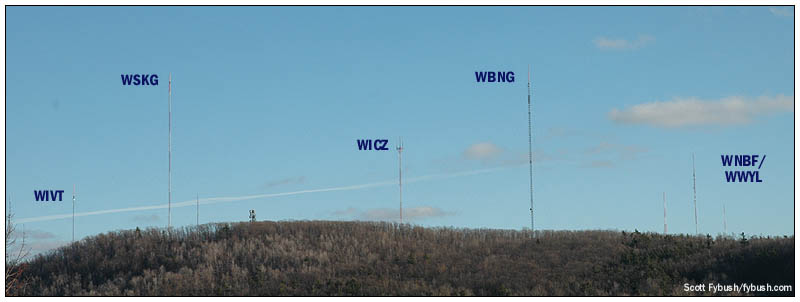
This is the view from the west, and so we're looking at the array of towers from WIVT on the north down to WNBF on the south - and we'll start our inside look with that big site on the south end of the hill, where the original 1941 transmitter building, with considerable expansion, still serves WNBF (1290), its Citadel FM sisters WAAL (99.1) and WWYL (104.1 Chenango Bridge), and Granite's WBNG-TV (analog 12/digital 7).
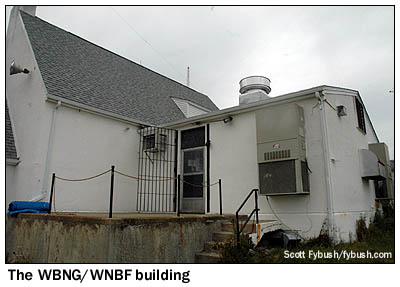 |
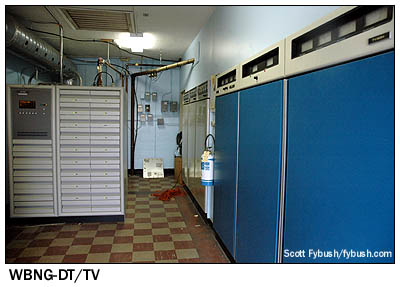 |
The original 1941 portion of the building is the steep-roofed section on the left, and when it was built, there was a Westinghouse 5 kW transmitter taking up much of the floor space there. It's long gone, and today the wall where it once sat is home to a Harris DX10 transmitter that serves as WNBF's main - and that unusual box with the big "V" on it shown below, next to the antenna switcher. What is it? We had to ask Citadel's regional director of engineering, Dave Edwards, who reports that it's a brand called Visual (model AM 5K-A), and quite a survivor - "That one still works, and we've driven it into a coat hanger and it still keeps on ticking," he says.
Forming an "L" with the AM transmitter wall is the row of FM transmitters at this site - a lower-powered Continental for WWYL, the class A signal that transmits from the top of WNBF's center tower, and a higher-powered Continental for class B WAAL, plus an aux in the middle.
The TV transmitters are in the addition on the right, just inside the front door: on the left in the photo above is the Harris that powers WBNG-DT, which stays on channel 7 after the transition; on the right are the vintage Gates BT-25 at rear and somewhat newer Harris TV30H that together have kept analog channel 12 on the air since back when it was WNBF-TV, but will soon be silenced forever.
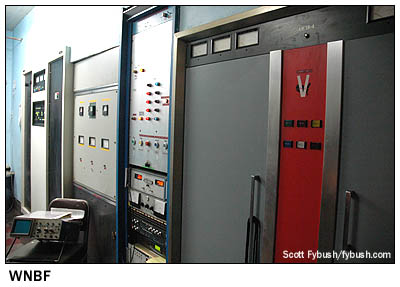 |
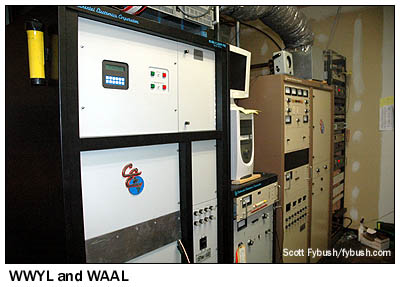 |
WNBF and its sister stations had the hill to themselves for more than 20 years, until the 1962 debut of ABC affiliate WBJA-TV (Channel 34), with studio and transmitter at the north end of Ingraham Hill Road, just before it begins its steep drop down into the city. Channel 34, now Newport Television's WIVT, is still up here - but while we did get a brief tour, we weren't allowed to take pictures for the website inside.
So we move on to the next TV facility to be built up here: about halfway between channel 34 and the WNBF site, on the east side of the hill, the lone candelabra-topped tower on the hill went up in 1968 for public station WSKG-TV (Channel 46), joined a few years later by NBC affiliate WINR-TV (Channel 40), which had been transmitting from the WINR (680) array northeast of downtown Binghamton, a spot that suffered nasty terrain shadowing in the growing suburbs west of town, especially up in the Vestal hills west of Ingraham.
Today, channel 40 - now Fox affiliate WICZ - has this site almost to itself, with WSKG-TV and WSKG-FM (89.3) having moved out (we'll see where they went in a moment), FM tenant WAAL having relocated to the channel 12 tower, and a newer FM tenant, WMXW (103.3 Vestal), also having moved out.
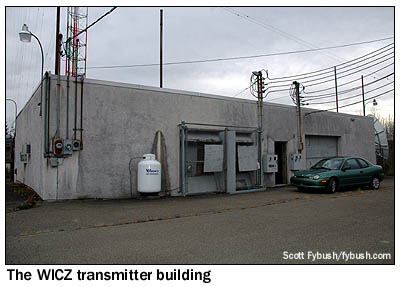 |
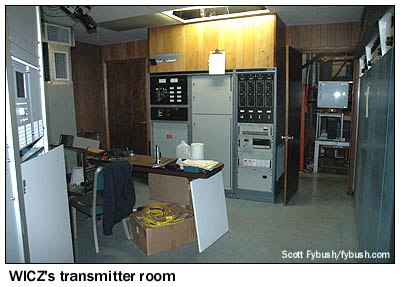 |
The transmitter building is still divided roughly in half, with WICZ on the left and the old WSKG space on the right. There's some older UHF gear keeping WICZ's analog operation going here - that RCA TTU-30A on the right was probably the original channel 40 transmitter from its 1971 move to the hill, and the solid-state Acrodyne at center looks to have come along a decade or so later.
In the foreground at left is WICZ-DT's Rohde and Schwarz transmitter, which will remain on channel 8 after the DTV transition.
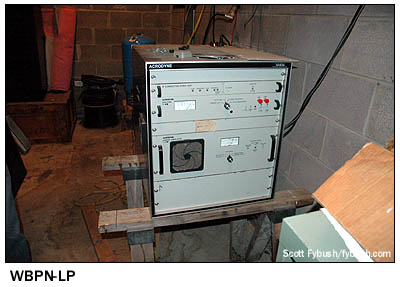 |
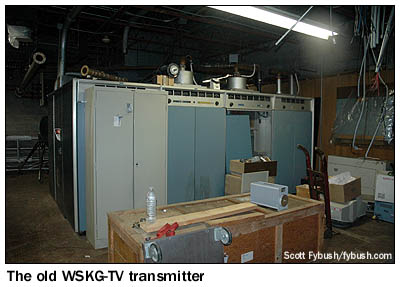 |
Across the entry hall, the space once occupied by WSKG is now used mainly for storage. The FM transmitter is gone, relocated to WSKG's new site as a backup, but WSKG's hulking RCA transmitter stayed behind, where it looks as though it's been cannibalized for parts for its sister unit next door at channel 40.
Behind WSKG's room is a small room with a little Acrodyne solid-state transmitter up on a sawhorse: this is WBPN-LP (Channel 10), aka "My 8," the My Network TV sister station to WICZ that's also seen on WICZ-DT's 40.2 subchannel (as well as on cable channel 8, hence its branding.) WBPN has a CP for a low-power digital operation on channel 23, though with coverage that would be completely duplicated by WICZ-DT itself, it seems almost redundant.
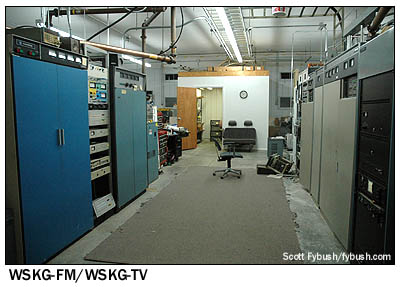 Out
behind the main building, a row of small outbuildings house TBN's
channel 26 LPTV signal, W26BS, as well as relative newcomer WLTB
(101.7 Johnson City), in the building that was once home to the
WAAL transmitter.
Out
behind the main building, a row of small outbuildings house TBN's
channel 26 LPTV signal, W26BS, as well as relative newcomer WLTB
(101.7 Johnson City), in the building that was once home to the
WAAL transmitter.
So what about WSKG's whereabouts? It's up the hill just a bit, on the new tower that went up in 2003 next door to channel 34, in amidst the quarry pits down a dirt road back in the woods.
Hiding back here is an awfully nice transmitter facility, where WSKG-FM's main Harris FM10-K and its backup RCA (which moved over from the channel 40 tower) sit across from the Comark analog transmitter for WSKG's channel 46 and (to the left of the Comark in the distance) the new Thales digital transmitter for WSKG-DT, which stays on channel 42 after the transition.
There's a row of cages (behind us as we took the WSKG picture) that houses the other FMs at this site - Clear Channel's WMXW (103.3), which moved from the channel 40 tower, and Citadel's WHWK (98.1), which moved here from the channel 12 tower.
We'll have to come up here again in a few years to see how things have settled down after the DTV conversion - and in the meantime, we'll continue our look at the last days of analog TV next week in our nation's capital.
Thanks to Chris Ball of WBNG, Dave Edwards of Citadel, Mike Pufky and Dave Frost of WSKG, Abiodun Sadik of WIVT and Larry Brown of WICZ for the tours!
- Previous Site of the Week: The Helderbergs, Albany, NY
- Next Week: WRC, Washington, DC
- Site of the Week INDEX!
- How can you help support Site of the Week? Click here!
- Submit your suggestions for a future Site of the Week!
